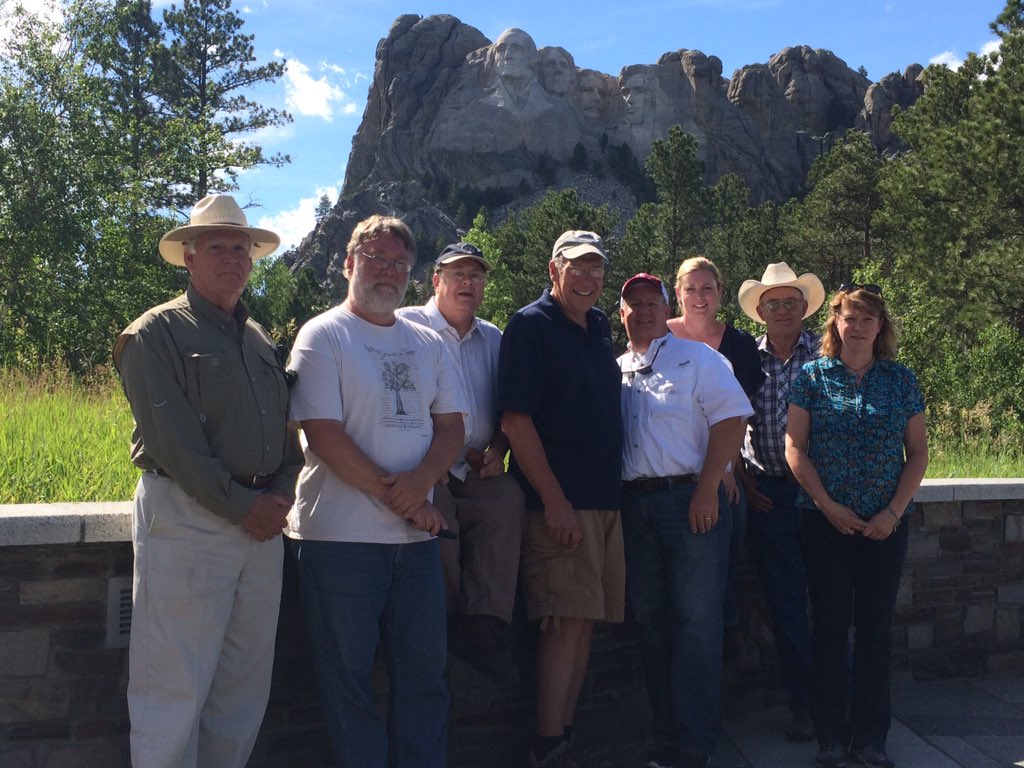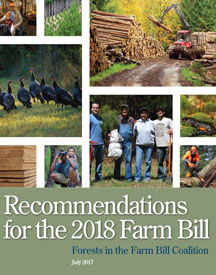
The NACD Forestry RPG explores Deadwood
The NACD Forestry Resource Policy Group (RPG) met in Deadwood, South Dakota, in conjunction with the National Association of State Foresters’ (NASF) Forest Resources Management Committee.
The Forestry RPG heard from a variety of presenters during the three-day meeting, including:
-
Assistant State Conservationist for Technology Kory Bossert discussed how South Dakota NRCS has coordinated outreach with private landowners to educate them about beetle outbreaks. Convincing landowners to cut their trees can be a challenge. “Forest management isn’t so much about the forest itself,” he said, “it’s about convincing people what the forest should look like.”
-
Tami Moore and Tina DeHaii of the South Dakota Association of Conservation Districts gave a joint presentation on forestry outreach efforts in the state. The state association has helped plant more than 350,000 acres of trees since records first began in 1944, mostly windbreaks. The installations are more diverse today than ever before, protecting structures, wildlife habitat, and enhancing countryside aesthetics. Soil types help to determine each windbreak design. Districts in South Dakota also help install fabric around streambank plantings. It’s an income generator and creates a moisture barrier for maximum growth. Moore and DeHaii showed a video of a brush management vehicle local conservation districts use to help landowners manage brush and invasives efficiently.
-
Sarah Anderson, program manager for Wyoming’s Crook County Natural Resource District, shared how districts in her state work with partners to combat mountain pine beetle and establish a more resilient forest. Wyoming and South Dakota work across state boundaries through the Mountain Pine Beetle Working Group in the Black Hills Region, where Ponderosa Pine has been a perfect host for the pests. According to Anderson, resource managers in the area have experienced better success ‘baking’ beetles than the more commonly accepted practice of relying on cold weather. “Bringing all of the partners together was not easy,” she said, “and conservation districts helped to make those connections and break down the red tape.”
Partners from the U.S. Forest Service, Natural Resources Conservation Service, National Agroforestry Center, American Forest Foundation, and National Wild Turkey Federation also provided organization updates during the meeting.
During the field tour, attendees visited a number of sites that showcased ways in which conservation districts in South Dakota and Wyoming are working with state forestry agencies to address forest resource concerns.
The Forestry RPG held its annual business meeting on the final day of the conference. The group reviewed progress from its strategic plan and its nationwide conservation district forestry network.
“It’s always great to see conservation district forestry in action in some part of the country,” Forestry RPG Chairman Steve Hedstrom said. “And we appreciated the opportunity to meet jointly with our state forestry friends and shared partners. It brought many perspectives to this meeting.”
NACD supports Farm Bill Coalition recommendations
 The Forests in the Farm Bill Coalition (FIFB) released its 2018 Farm Bill recommendations in mid-July. The National Association of Conservation Districts has been an active participant in the creation of the recommendations, serving on two of the coalition’s working groups to ensure that NACD’s policies and principles were included. The Forests in the Farm Bill Coalition (FIFB) released its 2018 Farm Bill recommendations in mid-July. The National Association of Conservation Districts has been an active participant in the creation of the recommendations, serving on two of the coalition’s working groups to ensure that NACD’s policies and principles were included.
“The public expects clean air and water, healthy soils, and abundant wildlife habitat and our nation’s forest lands certainly provide opportunities to achieve these expectations,” NACD President Brent Van Dyke said. “The farm bill is one of the most important pieces of legislation Congress works on to address our nation’s forest lands and landowner needs. Locally-led, voluntary incentive-based conservation works.”
The coalition welcomed input from a diverse group of forestry stakeholders in the consensus building process, and NACD is pleased with the recommendations brought forth through this collaborative process.
“These recommendations show the importance of and need for strong forestry programs. This consensus effort highlights the fact that despite differing and diverse perspectives, there are still numerous areas in which the forestry community can come together to provide Congress with a series of policy improvements,” NACD CEO Jeremy Peters said.
As Congress continues to work on drafting the next farm bill, NACD will continue to work tirelessly to educate lawmakers on Capitol Hill about the critical importance of locally-led conservation.
Click here to view the full recommendations.
Agroforestry conference attracts attendees from a dozen countries
More than 160 agroforestry researchers, technical assistance providers, students, and practitioners shared their research, experience, and insights in June at the 15th annual North American Agroforestry Conference, held in Blacksburg, Virginia. The four-day conference was organized by the Association for Temperate Agroforestry.
The conference hosted more than 100 presentations and 40 poster presentations, and attracted attendees from the U.S., Canada, Mexico, and nine other countries. Attendees visited Virginia Tech agroforestry research and demonstration sites and nearby farms that practice agroforestry.
The conference keynote speakers were Eric Toensmeier, author of The Carbon Farming Solution, and Victor Harris, editor of Minority Landowner Magazine. In addition, the conference included a policy forum titled “Advancing Agroforestry Policy: Lessons from North America and Europe.” Panelists included National Agroforestry Center Director Susan Stein, Henry de Gooijer of Agriculture and Agri-Food Canada, Ana Isabel Moreno Calles of National Autonomous University of Mexico, and Maria Rosa Mosquera Losada of the European Agroforestry Federation.
Said Stein, “The North American Agroforestry Conference once again provided a unique forum for galvanizing partnerships, research, and technology transfer to advance agroforestry across a broad spectrum of disciplines, management goals, and geographies.”
More information about the conference can be found on the Association of Temperate Agroforestry website.
Forestry Briefs
Iowa - CDI recognizes windbreaks at annual meeting
Conservation Districts of Iowa (CDI) held its 2017 annual meeting in July in conjunction with NACD’s Conservation Forum and Tour. During its annual banquet, CDI recognized several landowners for their use of windbreaks. David and Kathi Goeman of Wright County use a variety of species in their nine-row windbreak to attract wildlife and protect against disease outbreaks. The Goemans rely on sawdust as mulch to maintain soil moisture as an alternative to heavy watering. James and Jean Eischeid also use a variety of tree species and have used tree protectors for their seven-row windbreak in Carroll County. The Drapers in Grundy County were recognized for the shelterbelt that surrounds three sides of the family’s farm. CDI has been recognizing windbreak award winners since 1977.
Montana - District explores proposal to manage federal lands
The Lake County Conservation District is collecting comments on its proposal to give local control for the management of federal lands. The proposal calls for allowing the conservation district to contract with the state to manage Flathead Forest lands adjacent to the 56,000-acre Swan State Forest. The revenues raised through logging those lands would be reinvested in fuel reduction projects in the area on both private and public lands.
District Chairman Jim Simpson said he plans to make a decision in September or October on whether to move forward with the proposal after reviewing all of the comments. Many of the comments he has received thus far have come from outside the area, he said. Click here to read more.
Maine - Districts sponsor forest stewardship tours
The Waldo County Soil and Water Conservation District and Maine Forest Service are co-sponsoring a series of short field tours to highlight forest stewardship and conservation practices of private landowners. The free tours are open to landowners, foresters, loggers, and others interested in the stewardship of small woodlands. Dates for the first three tours have been set for July, August, and September. Read the full article here.
|
|
|
|
|
Email Marketing By
|


|
|
|
|
|